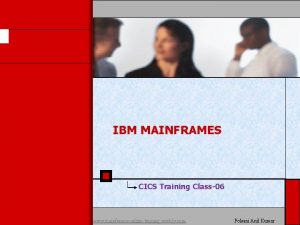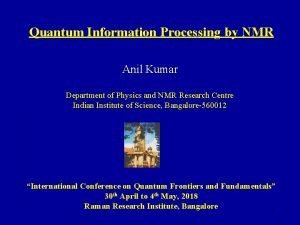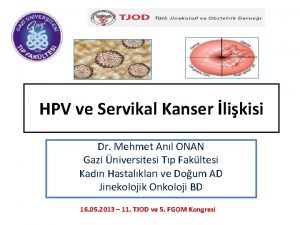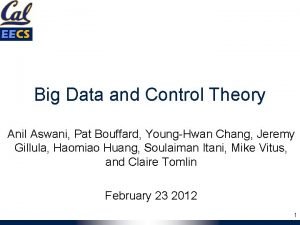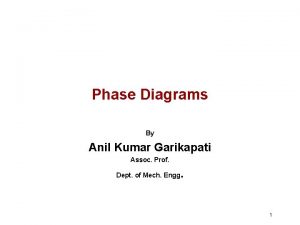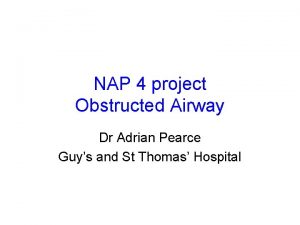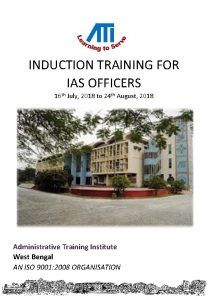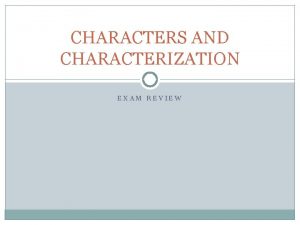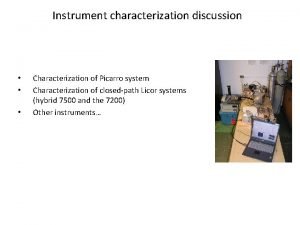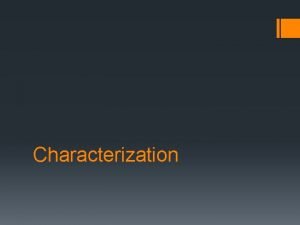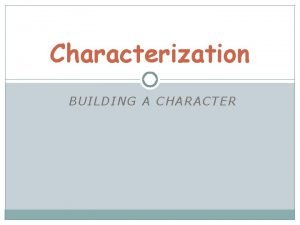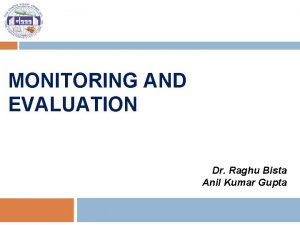SPECpowerssj 2008 Characterization Anil Kumar Larry Gray and


























- Slides: 26

SPECpower_ssj 2008** Characterization Anil Kumar, Larry Gray and Harry Li Intel® Corporation SPEC Workshop – January 27, 2008 * Other names and brands may be claimed as the property of others ** SPEC and the benchmark names are trademarks of the Standard Performance Evaluation Corporation SPEC Workshop January 2008

Agenda § SPECpower_ssj 2008 quick overview § SPECpower_ssj 2008 initial characterization □ System resources utilization □ Impact of JVM Optimizations □ Frequency scaling □ Processor scaling □ Platform generation scaling § General observation § Summary 10/2/2020 SPEC Workshop January 2008 2

SPECpower_ssj 2008 Quick overview 10/2/2020 SPEC Workshop January 2008 3

build slide SPECpower* - A “Graduated” Workload First: A Calibration Phase: Run to Peak Transaction Throughput □ # warehouses or threads = # cores, scheduling is “ungated” Next: Load Levels: Gradations Based on Calibrated Throughput § Average of last two calibration levels = peak calibrated throughput § Example Below is x 10 or 10% increments – the benchmark Actual Average Per Cent of Calibrated Peak Throughput 99. 8% 90. 1% 79. 6% 60. 2% 49. 9% 40. 1% 30. 6% 20. 0% 9. 9% SPECpower_ssj 2008 – Power and Processor % SPECpower_ssj 2008 – Transactions Dual-Core Intel Xeon 3. 0, 4 x 1 GB, 1 x HDD, Pwr Mgmt On ~ Peak Throughput calibration levels 69. 7% ~40% ~20% ~100% ~80% Active Idle Runs and Reports a “Load Line” 10/2/2020 SPEC Workshop January 2008 4

Controlling Measurements Exit SSJ_2008 Reporter Active idle SSJ@10% SSJ@20% SSJ@70% SSJ@80% SSJ@90% SSJ@100% Calibration n Calibration 2 Calibration 1 Calibrations SSJ_2008 Initialization Active Idle Graduated Load Levels § Each load level is a 240 second “measurement interval” plus, □ “inter” (delay between load level), □ ramp up (pre-measurement) □ ramp down measurement interval 240 seconds Post-measurement 30 secs Delay between load level 10 secs (post-measurement) GO Power STOP Measurement Pre-measurement 30 secs Delay between load level 10 secs operations per second Load level § Settle time and proper synchronization are essential § Consistent Power and Performance Measurement time 10/2/2020 SPEC Workshop January 2008 5

SPECjbb 2005 vs. SSJ_OPS@100% SSJ_2008 derived from SPECjbb 2005 - But different! § Base code and transaction types from SPECjbb 2005 Substantive changes! The two are not comparable: § Notable Differences □ Different transaction mix □ Transaction scheduling and timing □ Modified throughput accounting □ Data collection via network – TCP/IP □ More logging increases disk I/O □ Plus others 10/2/2020 SPEC Workshop January 2008 6

SPECpower_ssj 2008 - Metric Definition The Primary Metric for SPECpower_ssj 2008: “overall ssj_ops/watt” = ∑ 11 avg-trans-rate pts / ∑ 11 power pts (includes power at the active idle state) Table from SPECpower_ssj 2008 Full Disclosure Report Performance Target Load Actual Load Power Average Power (W) ssj ops Performance to Power Ratio 100% 99. 10% 220, 306 276 799 90% 90. 40% 200, 860 269 746 80% 79. 50% 176, 684 261 677 70% 70. 30% 156, 344 254 616 60% 59. 60% 132, 525 245 541 50% 49. 60% 110, 222 237 465 40% 40. 20% 89, 388 229 390 30% 30. 10% 66, 875 221 302 20% 19. 90% 44, 157 213 207 10% 10. 20% 22, 649 206 110 Active Idle 0 198 0 ∑ssj_ops / ∑power = ssj_ops@100% average power each level performance / power each level overall ssj_ops/watt 468 SPECpower_ssj 2008 Intel publication http: //www. spec. org/power_ssj 2008/results/res 2007 q 4/power_ssj 2008 -20071129 -00017. html Lots of data in rest of the report ! 10/2/2020 SPEC Workshop January 2008 7

Initial characterization of SPECpower_ssj 2008 10/2/2020 SPEC Workshop January 2008 8

Hardware and Software § SUT: Intel® “White Box” □ □ □ Dual and Quad Core Intel® Xeon® 2. 0 & 3. 0 GHz Supermicro* X 7 DB 8/ Main Board, Super Micro 5000 P (Blackford chipset) 4 x 2 GB FBDIMMs 1 x 700 W PSU 5 U Tower Platform § Microsoft* Windows Server 2003 64 bit □ Power Options: Server Balanced Processor Power and Performance § JVM: BEA* JRockit* P 27. 4. 0 64 bit □ JVM Command Line similar to published results § Sampling Rates: □ Power: 1 second (average from meter) § SPECpower_ssj 2008 setup □ SSJ Director on SUT □ load levels 120 seconds 10/2/2020 SPEC Workshop January 2008 9

Collecting OS Counters § Intel Written Daemon “OSctr. D. exe” □ Counters defined in ccs. props § Daemon runs on SUT, □ Data to CCS via TCP/IP □ Can run on CCS □ CCS logs counters along with watts, trans, etc. § “Integrated” Log □ advantage § Windows Only □ Linux port under consideration 10/2/2020 SPEC Workshop January 2008 10

SSJ_2008 Memory Usage § Code footprint: □ ~1. 5 M (total of all methods JIT’ed and optimized) § Data footprint: □ ~50 MB per warehouse “database” size □ ~8 KB of transient objects per transaction § JVMs □ 32 bit JVM - Max. 4 GB heap □ 64 bit JVM - much larger heap (max. 264 Bytes) □ Multiple instances can/will increase memory footprint § Optimal memory size is throughput capacity dependent □ Platform and configuration specific § Example: Quad-Core Intel Xeon based Dual Processor system □ ~8 GB optimal for SPECpower_ssj 2008 § All above specific to BEA JRockit JVM 10/2/2020 SPEC Workshop January 2008 11

Transactions (SSJ OPS) § CPU % tracks load § CPU % expected to track on Intel Core 2 architecture § Other architectures will vary (SMT etc. ) § Load level targets are % of SSJ_OPS@calibrated § CPU utilization is no part of the benchmark 10/2/2020 SPEC Workshop January 2008 12

Power and Processor Utilization § Average SSJ OPS tracking as expected per level □ Throughput per sec showing expected variability within load level § Negative Exponential inter-arrival time batch scheduling § Power consumption varies with load 10/2/2020 SPEC Workshop January 2008 13

All Three (SSJ OPS, CPU% and Power) § At all load levels including active idle: □ All three, SSJ OPS, CPU % utilization and Average Watts □ tracking as expected 10/2/2020 SPEC Workshop January 2008 14

Memory Utilization § With typical tuning (Xmx==Xms), Java heap allocated remains same throughout the run □ committed memory in use remains constant at all load levels including active idle 10/2/2020 SPEC Workshop January 2008 15

Network I/O § ~1500 Bytes/sec of network I/O at all load levels including active idle: □ Network I/O from per sec request/response between Control & Collect (CCS) and SSJ_2008 Director 10/2/2020 SPEC Workshop January 2008 16

Disk I/O § Disk I/O – Regular bursts of ~140 Kbyte writes, □ ~3. 3 Kbytes/sec average for all load levels □ Most disk writes related to SSJ_2008 logging § Disk reads average zero 10/2/2020 SPEC Workshop January 2008 17

C 1 state § % Time in C 1 State – Inverse of CPU % □ C 1/C 1 E Time contributes to power saving § Varies with architecture, OS and policies □ Intel EIST and C 1 E “enabled” in BIOS 10/2/2020 SPEC Workshop January 2008 18

Basic system events § Interrupts: ~700 /sec at all load levels § Context switches ~800 /sec □ Below 50% declining to ~400 at active idle § Rates OS and platform dependent § More Investigation Needed Here 10/2/2020 SPEC Workshop January 2008 19

Impact of JVM Optimizations § Experiment with JVM Options □ JAVAOPTIONS_SSJ=“ “ (None, default heap and optimization) □ JAVAOPTIONS_SSJ=“-Xms 3000 m -Xmx 3000 m -Xns 2400 m -XXaggressive XXlarge. Pages -XXthroughput. Compaction -XXcallprofiling -XXlazy. Unlocking Xgc: genpar -XXtlasize: min=12 k, preferred=1024 k” § Performance Loss ~50% § Power Less by 0 to 3% less § Your Results dependent on JVM and options 10/2/2020 SPEC Workshop January 2008 20

Processor scaling Dual Core to Quad Core (Intel Xeon) Dual Core Intel Xeon Quad Core Intel Xeon: % increase SSJ_OPS@100% 77% Power@100% 1% Overall SSJ_OPS/Watt 73% 10/2/2020 (2. 0 GHz / 4 MBL 2) (2. 0 GHz 2 x 4 MBL 2) § SSJ_OPS@100% increased by ~77% § Similar power@100% § Overall SSJ_OPS/Watt improved by ~73% SPEC Workshop January 2008 21

Frequency scaling Quad Core Intel Xeon % increase 2 GHz-->3 GHz 50% SSJ_OPS@100% 24% Power@100% 10% Overall SSJ_OPS/Watt 16% 10/2/2020 § 2. 0 to 3. 0 GHz Quad Core Intel Xeon (2 x 6 MBL 2): § Frequency increase of 50% □ SSJ_OPS@100% increases by ~24% □ Power@100% increased by ~10% □ Overall SSJ_OPS/Watt improved by ~16% SPEC Workshop January 2008 22

Platform generation scaling § Quad Core Intel Xeon 2. 0 GHz vs. Single Core Intel Xeon 3. 6 GHz: □ SSJ_OPS@100% improves by ~5. 4 x □ Power@100% less by ~20% for newer generation □ Overall SSJ_OPS/Watt improves by ~5. 4 x Performance Power(W) Overall Announced Processor in 2 Socket Platform SSJ_OPS@100% ssj_ops/Watt Single Core Intel Xeon 3. 6 GHz / 1 MB L 2 with HT 40, 852 336 87 Q 2 2006 Dual Core Intel Xeon 3. 0 GHz/4 MB L 2 163, 768 291 338 Q 4 2006 Quad Core Intel Xeon 2. 0 GHz/2 x 4 MB L 2 220, 306 276 468 2005 10/2/2020 SPEC Workshop January 2008 23

General observation § CPU Utilization – follows the load line (architecture dependent) § % Time in C 1 State – Inverse of CPU % □ C 1 Transitions per second – highest at idle § Memory % Committed – constant across load line § Disk I/O – Regular bursts of ~140 K byte writes, □ ~3. 3 K bytes/sec for all load levels § Network I/O - ~2. 5 K Bytes/sec, ~constant across load line § Basic system events require more investigation § Benchmark metric and other data do effectively show scaling with frequency, cores and across platform generation 10/2/2020 SPEC Workshop January 2008 24

Summary § First look, more refinements required □ More measurements planned for in-depth characterization § Results are specific to the platform and OS measured, etc § SPEC FDR contains unprecedented amount of data § Some system resources track graduated loads § Benchmark metric and data fairly reflect configuration and OS Setting changes § We are just getting started. 10/2/2020 SPEC Workshop January 2008 25

END SPEC Workshop January 2008
 Anil kumar polsani
Anil kumar polsani Anil kumar nmr
Anil kumar nmr Larry gray md
Larry gray md 2008 2008
2008 2008 What is indirect and direct characterization
What is indirect and direct characterization Direct vs indirect characterization
Direct vs indirect characterization Sunderlal bahuguna quotes
Sunderlal bahuguna quotes Wasallim wa radhiyallahu
Wasallim wa radhiyallahu Toppcluster
Toppcluster Anil hassan
Anil hassan Savex technologies pvt ltd bhiwandi
Savex technologies pvt ltd bhiwandi Mehmet anıl onan
Mehmet anıl onan Anil khamis
Anil khamis Blood relation definition
Blood relation definition Dr anil kakunje
Dr anil kakunje Anil aswani
Anil aswani Anil vachani
Anil vachani Anil sultan
Anil sultan Dr anil rao
Dr anil rao Introducing neeta anil said
Introducing neeta anil said Dr anil choudhary
Dr anil choudhary Dr anil pawa
Dr anil pawa Dr adrian pearce
Dr adrian pearce Basant kurre ias
Basant kurre ias Dr anil mehndiratta goa
Dr anil mehndiratta goa Go direkt
Go direkt Anil chawla law associates llp
Anil chawla law associates llp
